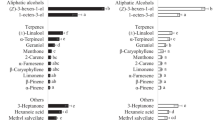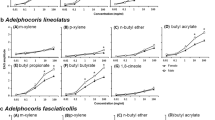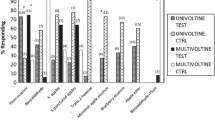Abstract
There is growing evidence that insects rely on chemical cues to locate food, hosts, predators, and potential mates. The pulse beetle Callosobruchus maculatus has been recognized for decades as the major post-harvest insect pest of legume seeds. In a previous study, we identified five volatile organic compounds in the headspace of dried green pea seeds as electroantennographically active in C. maculatus antennae: 1-pentanol, 1-octen-3-ol, (E)-2-octenal, nonanal, and 3-carene. Some of these compounds used individually elicited attraction toward C. maculatus adults. However, since volatile compounds are generally perceived by insects as blends, we hypothesized that C. maculatus might particularly show attraction to different mixtures of the aforementioned compounds. To test this, we examined the behavioral response of C. maculatus toward a quinary, a quaternary, two ternary, and three binary mixtures in a dual choice Y-tube olfactometer. The results seem to indicate that in a dual choice situation, the first choice made by the beetles is an indication of the attractive or repellent properties of the mixture tested. In most cases, a positive response of C. maculatus to the mixtures of volatiles was observed. Females were attracted to five mixtures, while males were attracted only to two binary mixtures consisting exclusively of aldehydes. The other mixtures caused C. maculatus to respond negatively, suggesting they were repellent. Further investigations with the attractive mixtures should be done in real storage conditions with the aim of developing a trap for the pulse beetle, C. maculatus.







Similar content being viewed by others
References
Adhikari P, Mukherjee A, Barik A (2014) Role of surface wax alkanes from Lathyrus sativus L. seeds for attraction of Callosobruchus maculatus (F.) (Coleoptera: Bruchidae). J Stored Prod Res 59:113–119
Allotey J, Oyewo EO (2004) Some aspects of the biology and control of Callosobruchus maculatus on some stored soybean, Glycine max (L) Merr varieties. African J Food Agri Nutr Dev 4(2):1–13
Arnold SEJ, Stevenson PC, Belmain SR (2012) Odour-mediated orientation of beetles is influenced by age, sex and morph. PLOS ONE 7:1–7
Babu A, Hern A, Dorn S (2003) Sources of semiochemicals mediating host finding in Callosobruchus chinensis (Coleoptera: Bruchidae). Bull Entomol Res 93:187–192
Bandara K, Saxena RC (1995) A technique for handling and sexing Callosobruchus maculatus (F.) adults (Coleoptera: Bruchidae). J Stored Prod Res 31:97–100
Beck CW, Blumer LS (2014) A handbook on bean beetles, Callosobruchus maculatus. http://www.beanbeetles.org/handbook/handbook.pdf. Accessed 28 August 2014
Beyaert I, Wäschke N, Scholz A, Varama M, Reinecke A, Hilker M (2010) Relevance of resource-indicating key volatiles and habitat odour for insect orientation. Anim Behav 79:1077–1086
Brown L, Downhower JF (1988) Analyses in behavioral ecology: a manual of lab and field. Sinauer Associates, Sunderland
BruceTJA Wadhams LJ, Woodcock CM (2005) Insect host location: a volatile situation. Trends Plant Sci 10:269–274
CAB International (2007) Crop Protection Compendium. Wallingford, UK
Campbell JF (2006) Stored-product insect behavior. In: Heaps JW (ed) Insect management for food storage and processing, 2nd edn. AACC International, Minnesota, pp 39–51
Collins LE, Wakefield ME, Chambers J, Cox PD (2004) Progress towards a multi-species lure: comparison of behavioural bioassay methods for multi-species attractants against three pests of stored grain. J Stored Prod Res 40:341–353
Collins LE, Bryning GP, Wakefield ME, Chambers J, Cox PD (2007) Progress towards a multi-species lure: identification of components of food volatiles as attractants for three storage beetles. J Stored Prod Res 43:53–63
Costello SL, Negron JF, Jacobi WR (2008) Traps and attractants for wood-boring Insects in ponderosa pine stands in the black hills, South Dakota. J Econ Entomol 101:409–420
Davidson MM, Butler Teulon RCD (2006) Starvation period and age affect the response of female Frankliniella occidentalis (Pergande) (Thysanoptera: Thripidae) to odor and visual cues. J Insect Physiol 52:729–736
Gunawardena NE, Herath HMWKB (1995) Enhancement of the activity of ferrugineol by n-pentanol in an attractant baited trap for the coconut pest Rhynchophorus ferrugineus (F.) (Coleoptera: Curculionidae). J Natl Sci Found Sri Lanka 23:81–86
Hagstrum D, Subramanyam B (2009) Stored-product insect resource. AACC International, St. Paul
Holighaus G, Weissbecker B, von Fragstein M, Schütz S (2014) Ubiquitous eight-carbon volatiles of fungi are infochemicals for a specialist fungivore. Chemoecology 24:57–66
Hu F, Zhang GN, Wang JJ (2009) Scanning electron microscopy studies of antennal sensilla of bruchid beetles, Callosobruchus chinensis (L.) and Callosobruchus maculatus (F. (Coleoptera: Bruchidae). Micron 40:320–326
Ignacimuthu S, Wäckers FL, Dorn S (2000) The role of chemical cues in host finding and acceptance by Callosobruchus chinensis. Entomol Exp Appl 96:213–219
Mason LJ, McDonough M (2012) Biology, behavior, and ecology of stored grain and legume insects. In: Hagstrum DW, Phillips TW, Cuperus G (eds) Stored product protection. K State Research and Extension, Kansas, US, pp 7–20
Mbata GN, Shu S, Amaswamy SB (2000) Sex pheromones of Callosobruchus subinnotatus and C. maculatus (Coleoptera: Bruchidae): congeneric responses and role of air movement. Bull Entomol Res 90:147–154
Messina FJ, Barmore JL, Renwick AA (1987) Oviposition deterrent from eggs of Callosobruchus maculatus: spacing mechanism or artifact? J Chem Ecol 13:219–225
Mitchell R (1990) Behavioral Ecology of Callosobruchus maculatus. In: Fujii K, Gatehouse AMR, Johnson CD, Mitchell R, Yoshida T (eds) Proceedings of the second international symposium on bruchids and Legumes. Okayoma, Japan. Springer, Netherlands, pp 317–330
Mueller DK, van Ryckeghem A (2006) Pheromones for stored-product protection. In: Heaps JW (ed) Insect management for food storage and processing, 2nd edn. AACC International, Minnesota, pp 153–164
Mushobozy DK, Pierce HDJR, Borden JH (1993) Evaluation of 1-Octen-3-o1 and nonanal as adjuvants for aggregation pheromones for three species of cucujid beetles (Coleoptera: Cucujidae). J Econ Entomol 86(6):1835–1845
Nahdy MS, Silim SN, Ellis RH (1999) Effect of field infestations of immature pigeonpea (Cajanus cajan (L.) Millsp.) pods on production of active (flight) and sedentary (flightless) morphs of Callosobruchus chinensis (L.). J Stored Prod Res 35:339–354
Ndomo-Moualeu AF, Ulrichs C, Weissbecker B, von Fragstein M, Schütz S, Adler C. Electroantennographic and behavioral activity of Callosobruchus maculatus (Fabricius, 1775) (Coleoptera: Chrysomelidae) induced by dried green pea and cowpea seed volatiles. unpublished
Ndomo AF, Weissbecker B, Schütz S, von Fragstein M, Reichmuth C, Adler C (2012) Olfactory responses of Plodia interpunctella (Hubner, 1813) (Lepidoptera: Pyralidae) to dried apricot volatiles. In: Navarro S, Banks HJ, Jayas DS, Bell CH, Noyes RT, Ferizli AG, Emecki M, Isikber AA, Alagunsundaram K (eds) Proceedings of the 9th international conference on controlled atmosphere and fumigation in stored products. ARBER Professional Congress Services, Antalya, pp 728–733
Nojima S, Shimomura K, Honda H, Yamamoto I, Ohsawa K (2007) Contact sex pheromone components of the cowpea weevil, Callosobruchus maculatus. J Chem Ecol 33:923–933
Oke OA, Akintunde EM (2013) Reduction of the nutritional values of cowpea infested with Callosobruchus maculatus (Coleoptera: Bruchidae). Int J AgriScience 3(1):30–36
Olsson POC, Anderbrant O, Löfstedt C, Borg-Karlson AK, Liblikas I (2005) Electrophysiological and behavioral responses to chocolate volatiles in both sexes of the pyralid moths, Ephestia cautella and Plodia interpunctella. J Chem Ecol 31:2947–2961
Olsson P-OC, Anderbrant O, Löfstedt C (2006) Attraction and oviposition of Ephestia kuehniella induced by volatiles identified from chocolate products. Entomol Exp Appl 119:137–144
Parr MJ, Tran BD, Simmonds MSJ, Kite GC, Credland PF (1998) Influence of some fatty acids on oviposition by the bruchid beetle, Callosobruchus maculatus. J Chem Ecol 24:1577–1593
Paukku S, Kotiaho JS (2008) Female oviposition decisions and their impact on progeny life-history traits. J Insect Behav 21:505–520
Radha R, Susheela P (2014) Studies on the life history and ovipositional preference Callosobruchus maculatus reared on different pulses. Res J Anim Vet Fish Sci 2(6):1–5
Reichmuth C, Schöller M, Ulrichs C (2007) Stored products pests in grain. Morphology-biology-damage-control. Agroconcept. Verlagsgesellschaft, Bonn
Shivanna BK, Ramamurthy BN, Gangadhara NB, Gayathri DS, Mallikarjunaiah H, Krishna NR (2011) Host preference of pulse beetles, Callosobruchus maculatus (Fab.) and C. analis (Fab.) on selected pulses. Int J Sci Nat 2(2):238–240
Singh VN, Pandey ND (2001) Growth and development of Callosobruchus chinensis Linn. on different varieties. Indian. J Entomol 63(2):182–185
Sokal RR, Rohlf FJ (1969) Biometry: the principles and practice of statistics in biological research. Freeman, San Francisco
Szendrei Z, Rodriguez-Saona C (2010) A meta-analysis of behavioral manipulation of insect pests with plant volatiles. Entomol Exp Appl 134:201–210
Thakeow P, Angeli S, Weißbecker B, Schütz S (2008) Antennal and behavioral responses of Cis boleti to fungal odor of Trametes gibbosa. Chem Senses 33:379–387
Uechi K, Matsuyama S, Suzuki T (2007) Oviposition attractants for Plodia interpunctella (Hübner) (Lepidoptera: Pyralidae) in the volatiles of whole wheat flour. J Stored Prod Res 43:193–201
Utida S (1972) Density dependent polymorphism in the adult of Callosobruchus maculatus (Coleoptera: Bruchidae). J Stored Prod Res 8:111–126
Wakefield ME, Bryning GP, Collins LE, Chambers J (2005a) Identification of attractive components of carob volatiles for the foreign beetles, Ahasverus advena (Waltl) (Coleoptera: Cucujidae). J Stored Prod Res 41:239–253
Wakefield ME, Bryning GP, Chambers J (2005b) Progress towards a lure to attract three stored product weevils, Sitophilus zeamais Motschulsky, S. oryzae (L.) and S. granarius (L.) (Coleoptera: Curculionidae). J Stored Prod Res 41:145–161
Acknowledgments
The German Academic Exchange Service (DAAD) is thanked for the PhD scholarship granted to Mrs Ndomo-Moualeu. Mrs Agnes Paul is acknowledged for providing the test insects and all the colleagues at the JKI/ÖPV for their support.
Conflict of interest
The authors declare that they have no competing interests.
Author information
Authors and Affiliations
Corresponding author
Additional information
Communicated by C. G. Athanassiou.
Rights and permissions
About this article
Cite this article
Ndomo-Moualeu, A.F., Ulrichs, C. & Adler, C. Behavioral responses of Callosobruchus maculatus to volatile organic compounds found in the headspace of dried green pea seeds. J Pest Sci 89, 107–116 (2016). https://doi.org/10.1007/s10340-015-0652-4
Received:
Revised:
Accepted:
Published:
Issue Date:
DOI: https://doi.org/10.1007/s10340-015-0652-4




